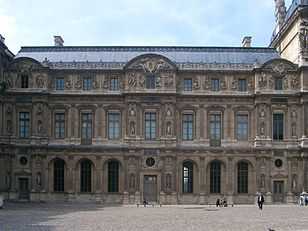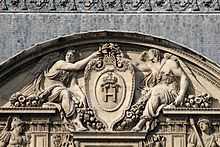Lescot Wing
Coordinates: 48°51′36.95″N 2°20′15.08″E / 48.8602639°N 2.3375222°E

The Aile Lescot (French, "Lescot Wing") is the oldest portion existing above ground level of the Louvre Palace, in Paris, France. The Wing was executed between 1546 and 1551. Strongly tinged with Italian Mannerism,[1] it became the Parisian Renaissance style, thus "setting the mold" for all later French architectural classicism .
Description
The Lescot Wing is situated between the Pavillon du Roi and the Pavillon Sully and overlooks the inner Cour Carré ("Square Court") of the "Old Louvre". It consists of two main stories plus an attic richly embellished with Jean Goujon's panels of bas-reliefs. It is crowned by a sloping roof, a traditional feature of French building and very practical in a rainy climate. The deeply recessed arch-headed windows of the ground story give the impression of an arcade, while the projecting pavilions bear small round oeil de bœuf windows above them. In the second storey slender fluted pilasters separate the windows, which alternate delicate triangular and arched pediments. Goujon's noble sculpture and architectural ornaments are cleverly subordinated to the construction, but the surviving ground floor Salle des Caryatides (1546–49) is named for Goujon's four caryatid figures that support the musicians' gallery.
History

King Francis I appointed architect Pierre Lescot (1510–1578) to take charge of the building projects at the Palais du Louvre. This was confirmed after Francois’ death by his heir Henry II and Lescot worked on the Louvre project until his death. Only the west side and part of the south side of the Lescot Wing were completed, comprising the present southwest wing of the Cour Carré.
Just to the north of the Lescot Wing, between the Pavillon Sully and the Pavillon de Beauvais, is the Aile Lemercier ("Lemercier Wing"). This was built between 1661 and 1663 under Louis XIII and Richelieu and is a symmetrical extension of Lescot's Wing in exactly the same Renaissance style. With the Lemercier Wing, the last external vestiges of the medieval Louvre were demolished.
Of Lescot's constructions at the Louvre outside of the Lescot Wing, there remain only the Salle des Gardes and the Henry II Staircase.
References
- ↑ Summerson, John (1963), The Classical Language of Architecture, London and New York: Thames & Hudson, pg 76.
External links
- "Façade of the Cour Carrée (Wing Lescot)" at the Web Gallery of Art.
- Lescot Wing webpage at Louvre Website
| ||||||||||||||||||||||||||||||||||||||